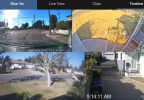This isn't really a practical setup, but just wanted to share a quick project. Grain of salt, this requires quite a bit of infrastructure so it's not for everyone, but I figured I'd share anyway. There are a lot of ways to do this, but I did it with mostly things I had lying around. Here's a screenshot:

TOPOLOGY OVERVIEW
Since BI supports RTSP streams, I assumed adding a dashcam with RTSP would work. I knew in advance BI would fail gracefully with RTSP streams cutting in/out, so I wanted to see if I could get everything working by simply building a remote transparent bridge. To do so, I decided to enable a wireguard VPN connection to my car. The dashcam would just be a remote client which the BI server at home would record whenever it came online.
PARTS USED
SETUP
SUMMARY
This actually worked out pretty well, but it's not necessarily practical. More of just a fun thing to try out.
The friction points right now are:A) the need to manually turn on wifi on the dashcam and B) relatively low performance for high data consumption cost.
For the first problem, this can likely be resolved pretty easily. I would have to research other types of dashcams which support wifi station mode on startup.
As for the second problem, the RTSP stream is limited to 480p and data consumption is roughly 600MB/hour of driving (about 1.3Mbps). Of course, an unlimited data plan would be recommended for this. I haven't yet found a way to see if the RTSP stream can be tuned, but perhaps there are ways to improve here as well.
EDIT
After getting in touch with Viofo to ask if they could enable wifi station mode when the camera boots up, they amazingly responded with a new firmware update. Very cool! This means the process starts up hands-free now.

TOPOLOGY OVERVIEW
Since BI supports RTSP streams, I assumed adding a dashcam with RTSP would work. I knew in advance BI would fail gracefully with RTSP streams cutting in/out, so I wanted to see if I could get everything working by simply building a remote transparent bridge. To do so, I decided to enable a wireguard VPN connection to my car. The dashcam would just be a remote client which the BI server at home would record whenever it came online.
PARTS USED
- Dashcam: Viofo A119 mini2 (must be on at least firmware V2.1_20241010 to enable wifi station mode)
- Mini Router: GL.iNet - GL-AR300M16 (to share internet to dashcam and enable VPN route)
- Internet: Android Phone with hotspot routine
SETUP
- Car LAN configuration:
- Create a routine on phone to turn on mobile hotspot sharing in the car. This is simple to do with android routines; I assume iOS is similar.
- The AR300M is great since it's powered by USB, so the easiest thing to do is to get a cigarette USB adapter and just have the router turn on whenever the car's ACC is on. In my case, I just threw the router into the center console since there's a cigarette plug there.
- Set the AR300M to repeater mode in order for it to access internet from the mobile hotspot and share its connection to the dashcam.
- Set a static DHCP assignment (e.g. 192.168.8.10) for the dashcam in the AR300M mini router, since the dashcam's limited config doesn't allow you to set static IPs. If you don't do so, the dashcam's address may change at each boot and the BI server won't be able to route to it.
- Camera Setup:
- I lucked out and my dashcam supports wifi station mode (with the latest firmware). This means I'm able to have it connect to the AR300M as a normal wifi client.
- However, one major hiccup is that wifi needs to be turned on each time the dashcam starts.
- VPN tunneling from car to home network:
- This is the meat of the project. The idea is to setup an IP tunnel which turns on whenever the car is in use. Once the car turns on, the tunnel is established. Once BI is able to see the connection, the stream will automatically start recording.
- Create a VPN tunnel to your BI site (home server). I already run wireguard, so that's what I went with, but this would work with openVPN too.
- The AR300M16 is perfect for this because it supports both openVPN and wireguard out of the box. Setting up VPN client tunneling on the AR300M16 is pretty trivial nowadays since it even lets you upload config files.
- For DNS reasons, I changed my phone's car routine to disable wifi on my phone before turning on the hotspot. Otherwise, the wireguard connection would try to connect to the LAN address for the VPN server.
- BI Server Setup:
- The final step is to ensure the BI server can see the camera through the IP tunnel. In my case, my BI server isn't normally part of the VPN. Because the dashcam is on its own subnet (192.168.8.0/24), I manually created a routing table entry on the BI server to route 192.168.8.0 traffic through the VPN gateway (192.168.3.20). In windows, the command looks something like this:
Code:route -P add 192.168.8.0 MASK 255.255.255.0 192.168.3.20 - After verifying I can reach the camera through the VPN tunnel, I added the camera into BI as a normal RTSP camera: RTSP:/192.168.8.10
- The final step is to ensure the BI server can see the camera through the IP tunnel. In my case, my BI server isn't normally part of the VPN. Because the dashcam is on its own subnet (192.168.8.0/24), I manually created a routing table entry on the BI server to route 192.168.8.0 traffic through the VPN gateway (192.168.3.20). In windows, the command looks something like this:
SUMMARY
This actually worked out pretty well, but it's not necessarily practical. More of just a fun thing to try out.
The friction points right now are:
For the first problem, this can likely be resolved pretty easily. I would have to research other types of dashcams which support wifi station mode on startup.
As for the second problem, the RTSP stream is limited to 480p and data consumption is roughly 600MB/hour of driving (about 1.3Mbps). Of course, an unlimited data plan would be recommended for this. I haven't yet found a way to see if the RTSP stream can be tuned, but perhaps there are ways to improve here as well.
EDIT
After getting in touch with Viofo to ask if they could enable wifi station mode when the camera boots up, they amazingly responded with a new firmware update. Very cool! This means the process starts up hands-free now.
Last edited:

